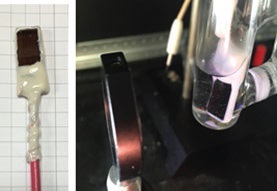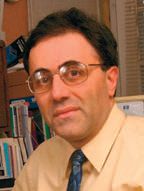Photoelectrochemical generation of hydrogen over 100% quantum efficiency
Dr. Neil Canter, Contributing Editor | TLT Tech Beat August 2017
A new photoelectrochemical cell generates better performance than a photovoltaic cell using the same anode and cathode electrodes.
KEY CONCEPTS
•
A photoelectrochemical cell has been developed that exhibits a quantum efficiency exceeding 100% in the ultraviolet-visible light range.
•
The cell used a technique known as multiple exciton generation that enables one high-energy photon to generate multiple electrons.
•
The researchers achieved this result by splitting hydrogen sulfide into its elemental species, hydrogen and sulfur.
FINDING APPROACHES TO INCREASE THE EFFICIENT CONVERSION OF SOLAR ENERGY into electricity and other useful products is a continuing focus of research. A good deal of attention has been paid to working with perovskites—crystalline materials containing organic and inorganic components.
A previous TLT article discussed research to determine the efficiency of perovskites (
1). A technique known as scanning photocurrent microscopy was used to measure the diffusion length for an organmetallic halide perovskite. This parameter represents the distance that an electron or a hole passes from the point of generation until either the two species recombine or the electrons are extracted into an electric field. To improve efficiency, the diffusion length must be extended. For this specific perovskite, the diffusion length is between 10-20 microns.
The use of solar energy to produce hydrogen through the splitting of water can be done by a number of methods. One attractive approach is through a photoelectrochemical process where semiconductor electrodes convert solar energy into the chemical energy of hydrogen.
Yong Yan, assistant professor in the chemistry and environmental science department at the New Jersey Institute of Technology in Newark, N.J., says, “There are three obstacles in the way of efficiently producing hydrogen using photoelectrochemistry. A material must be used that absorbs solar energy in a similar fashion to solar panels. The catalytic process for producing electrons and holes must be more effective to efficiently reduce water to hydrogen and oxidize water to form oxygen. These two processes must be compatible with each other.”
The challenge facing researchers is to maximize the external quantum efficiency, which is defined as the ratio of the number of electrons collected by the photoelectrode cell per second to the number of photons incident on the photoelectrode per second. Yan says, “When a photon interacts with the electrode, one electron and one hole pair are produced. The problem is that high-energy photons having energy levels greater than the semiconductor band gap produce high-energy species needing to relax. Unfortunately these species dissipate the extra energy as heat leading to a loss of efficiency.”
An approach that can be used to capture this extra kinetic energy is known as multiple exciton generation (MEG). Yan says, “In MEG, one high-energy photon can generate multiple excitons and then electrons leading to the potential for increasing the external quantum efficiency above 100%.”
Yan indicates that production of two electron-hole pairs can boost the external quantum efficiency to 200%. Development of a photoelectrochemical process that can boost the efficiency above 100% and also utilize photons in the more readily available, ultraviolet-visible light range may lead to a more efficient approach for producing hydrogen. Such a process has now been realized.
HYDROGEN SULFIDE SPLITTING
Yan and his colleagues developed a photoelectrochemical cell that exhibits an external quantum efficiency exceeding 100% in the ultraviolet-visible light range. He says, “Our system contains an anode consisting of a lead sulfide quantum dot electrode deposited on top of a fluorine-doped tin oxide/titanium dioxide dielectric stack and a cathode prepared from platinum.”
Yan continues, “Quantum dots consist of small quantities of semi-conductor particles a few nanometers in diameter that exhibit specific band gaps. These materials are very good at absorbing energy and generating electrons and holes. For our work, we chose lead sulfide because this compound has generated high MEG efficiency in the past.”
Figure 2 shows an image of the photoelectrode and the photoelectrochemical cell. The anode was placed in a one molar sodium sulfide aqueous solution to facilitate ion flow and the cathode was as in a phosphate-buffered solution in a separate compartment.
 Figure 2. A photoelectrode (left) was used in the photochemical cell on the right to achieve a quantum efficiency greater than 100% in the generation of hydrogen from solar energy. (Figure courtesy of New Jersey Institute of Technology.)
Figure 2. A photoelectrode (left) was used in the photochemical cell on the right to achieve a quantum efficiency greater than 100% in the generation of hydrogen from solar energy. (Figure courtesy of New Jersey Institute of Technology.)
The anode is exposed to white light that was passed through a monochromator where electrons, holes and hydrogen cations are produced. Electrons and hydrogen cations then move to the cathode where reduction leads to the formation of hydrogen gas. The holes oxidize sulfide to form free sulfur, which is dissolved in the sodium sulfide solution. A salt bridge was present to connect the anode to the cathode completing the electric circuit and enabling sodium and hydrogen cations to move from the anode to the cathode.
Yan says, “In fact, we are splitting hydrogen sulfide into its elemental species, hydrogen and sulfur.”
The cathode is kept in the dark to ensure that there is no interference with the light-illuminated anode. The researchers measured the amount of hydrogen generated at the anode to the known number of incident photons at a specific wavelength. In adjusting the wavelength of light, they found that the external quantum efficiency reached up to 120% with MEG producing two low-energy electrons from a single high-energy photon. This process is particularly effective at wavelengths of 450 nanometers and lower where a 10%-20% efficiency boost from MEG is achieved.
Yan indicates that this photoelectrochemical cell generates better performance than a photovoltaic cell using the same anode and cathode electrodes. He says, “In this system, it is very difficult for the photovoltaic cell to produce an external quantum efficiency above 100%. The problem is the hole recombination and the interference light absorption by the titanium dioxide in the ultraviolet-visible light range.
For the future, Yan is working to develop a photoelectrochemical cell that will split water. He says, “We need a better approach with more stable and applicable reactions that can take place at the anode and cathode.”
Additional information can be found in a recent reference (
2) or by contacting Yan at
yong.yan@njit.edu.
REFERENCES
1.
Canter, N. (2017), “Unraveling the effectiveness of perovskite solar cells,” TLT,
73 (4), pp. 12-13.
2.
Yan. Y., Crisp, R., Gu, J., Chernomordik, B., Pach, G., Marshall, A., Turner, J. and Beard, M. (2017), “Multiple exciton generation for photoelectrochemical hydrogen evolution reactions with quantum yields exceeding 100%,”
Nature Energy,
2, Article Number: 17052.
 Neil Canter heads his own consulting company, Chemical Solutions, in Willow Grove, Pa. Ideas for Tech Beat items can be sent to him at neilcanter@comcast.net
Neil Canter heads his own consulting company, Chemical Solutions, in Willow Grove, Pa. Ideas for Tech Beat items can be sent to him at neilcanter@comcast.net.